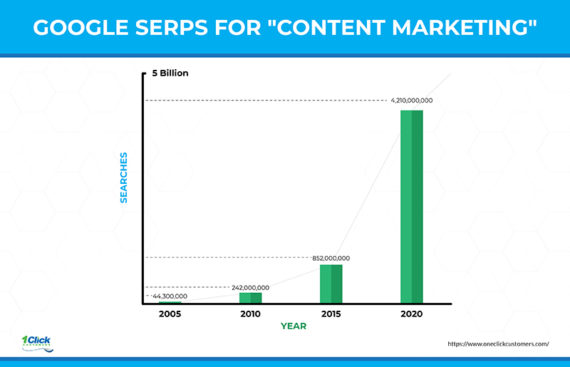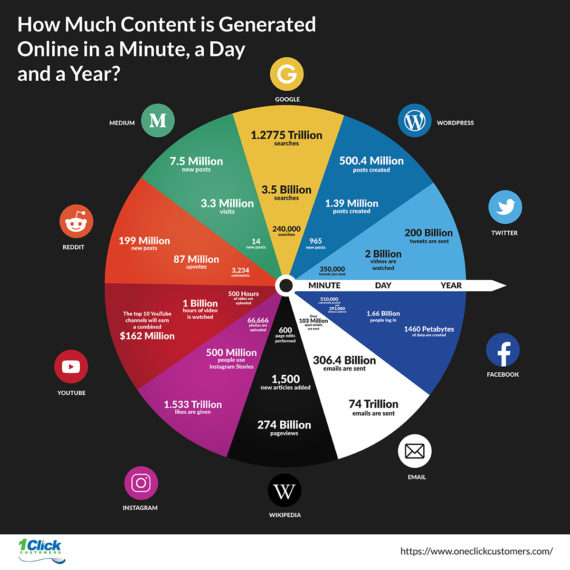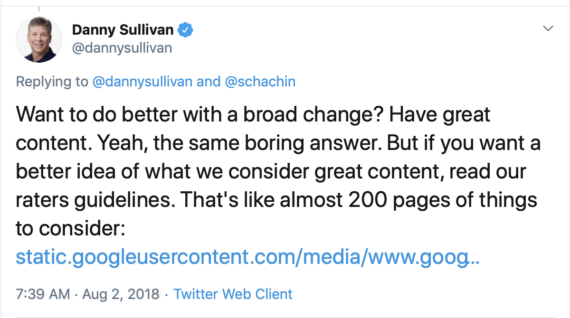Content is king, but the way we search for content has remained mostly unchanged for two decades. In the year 2000, the front page of Google showed 10 links, and with the exception of some rich media links like videos and featured snippets, the front page still shows 10 links.
While the way search results are shown hasn’t changed, the amount of data created online, and the sheer amount of content has skyrocketed in 20 years. Both supply and demand have grown exponentially, but the sweet spot for content is still being in one of those first 10 links on Google.




Perhaps an easier way to visualise how rapidly the amount of content available is growing is with a graph.

Exactly how much content is created online? In 2015, the global accumulated online data was around 4.4ZB (Zettabytes – a zettabyte is 1021 bytes), and by the end of 2020 the amount of accumulated data is expected to have increased tenfold to 44ZB. Such a massive amount of data is hard to visualise, but when the data was first released, the example given was that if you stacked 128Gb iPad Air tablets on top of each other, a 4.4ZB stack would make it two thirds of the way to the moon. A 44ZB stack would make it to the moon 6.6 times.
The digital world never slows, and the amount of data created by the minute, day and year is staggering.

*see data sources at the end of the article
So how do we, as marketers, break through the noise created by so much data? We have to make content that matters, not just for the hell of it. Every time we create content we have to ask if we are creating value for users. If we aren’t the content is just more data that is being thrown on the pile.
If content already exists on the topic, you have to think about how we can improve on the topic or bring something new and valuable to the table. Each piece of content should be hero content, not filler. This hero content could include creating video or graphics to illustrate your text, adding interest and value to readers, and giving added context and accessibility to content you create.
Another way you can add value to your content to rise to the top of the data pile is to create vernacular content. In the United States, it could be valuable to create content in both English and Spanish, given the large Spanish speaking population. In India where there are 22 regional languages, including Hindi, Telugu, Marathi, Punjabi, Gujarati, Bengali, Tamil and Urdu, it could be beneficial to create content for those regional groups and languages to better reach those audiences.
Ultimately, the key to ranking is having quality content and knowing how people search.

You can download the Google Search Quality Evaluator Guidelines by right clicking the link.
Data Sources
Wikipedia: https://en.wikipedia.org/wiki/Wikipedia:Statistics
WordPress: https://wordpress.com/about/
Facebook: https://www.forbes.com/sites/bernardmarr/2018/05/21/how-much-data-do-we-create-every-day-the-mind-blowing-stats-everyone-should-read/#40162f2560ba
https://www.statista.com/statistics/346167/facebook-global-dau/,
https://research.fb.com/blog/2014/10/facebook-s-top-open-data-problems/
Twitter: https://www.internetlivestats.com/twitter-statistics/
https://business.twitter.com/en/blog/how-video-is-reshaping-digital-advertising.html
Youtube: https://www.tubefilter.com/2019/05/07/number-hours-video-uploaded-to-youtube-per-minute/
https://www.youtube.com/about/press/
https://www.forbes.com/sites/maddieberg/2019/12/18/the-highest-paid-youtube-stars-of-2019-the-kids-are-killing-it/#2510e13838cdS
Instagram: https://www.omnicoreagency.com/instagram-statistics/
https://www.facebook.com/business/marketing/instagram#
Google: https://www.internetlivestats.com/google-search-statistics/
Email: https://books.google.com.au/books?id=YxOKDwAAQBAJ&pg=PT164&lpg=PT164&dq=103+million+spam+emails+are+sent&source=bl&ots=OqwWE4M-Wq&sig=ACfU3U35mp9cOoQsf18ZbDU2xmt2yR6IMg&hl=en&sa=X&ved=2ahUKEwjZnL7iopboAhXKyTgGHX3NB4cQ6AEwDHoECAkQAQ#v=onepage&q=103%20million%20spam%20emails%20are%20sent&f=false
https://www.statista.com/statistics/456500/daily-number-of-e-mails-worldwide/
Reddit:https://www.socialmediatoday.com/news/reddit-outlines-2019-performance-stats-and-trends/568471/
Medium: https://expandedramblings.com/index.php/medium-facts-statistics/
